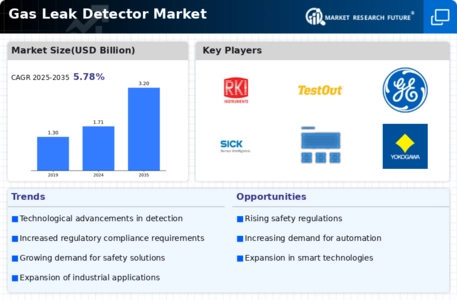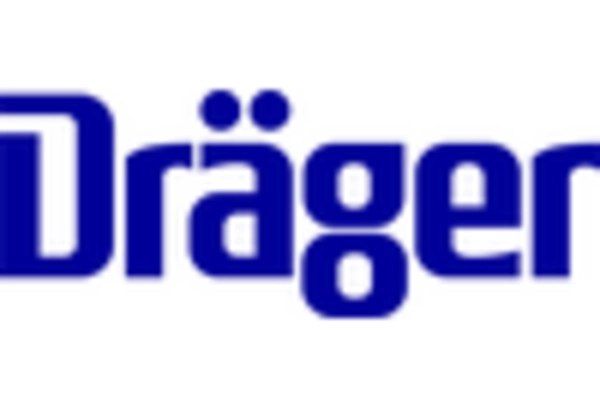Increasing Safety Regulations
The Gas Leak Detector Market is experiencing a surge in demand due to the implementation of stringent safety regulations across various sectors. Governments and regulatory bodies are emphasizing the need for enhanced safety measures in residential, commercial, and industrial settings. This regulatory push is likely to drive the adoption of gas leak detectors, as organizations seek to comply with safety standards. For instance, the Occupational Safety and Health Administration (OSHA) has established guidelines that necessitate the use of gas detection systems in workplaces. As a result, the market for gas leak detectors is projected to grow significantly, with estimates suggesting a compound annual growth rate (CAGR) of around 7% over the next few years. This trend indicates a robust market environment for manufacturers and suppliers of gas leak detection technologies.
Growth in the Oil and Gas Sector
The Gas Leak Detector Market is closely linked to the performance of the oil and gas sector, which continues to expand in various regions. As exploration and production activities increase, the need for effective gas leak detection systems becomes paramount to ensure operational safety and compliance with environmental regulations. The oil and gas industry is characterized by high-risk environments where gas leaks can have catastrophic consequences. Consequently, companies are investing heavily in advanced gas detection technologies to mitigate these risks. Market data indicates that the oil and gas sector accounts for a substantial portion of the overall demand for gas leak detectors, with projections suggesting a continued upward trend in investments in safety equipment. This growth trajectory is expected to bolster the gas leak detector market, providing opportunities for manufacturers to cater to the specific needs of this critical industry.
Expansion of the Residential Market
The Gas Leak Detector Market is experiencing notable growth in the residential sector, driven by increasing consumer awareness and the rising prevalence of natural gas usage in homes. As more households adopt natural gas for heating, cooking, and other applications, the demand for gas leak detectors is likely to rise correspondingly. Homeowners are becoming more proactive in ensuring safety measures are in place, leading to a surge in the installation of gas detection systems. Market Research Future indicates that the residential segment is projected to account for a significant share of the overall gas leak detector market, with estimates suggesting a growth rate of approximately 8% annually. This trend reflects a broader shift towards safety-conscious consumer behavior, positioning the gas leak detector market for sustained growth in the coming years.
Rising Awareness of Gas Leak Hazards
The Gas Leak Detector Market is witnessing heightened awareness regarding the dangers associated with gas leaks. Public campaigns and educational initiatives are increasingly informing consumers about the potential risks of gas leaks, including explosions and health hazards. This growing awareness is prompting homeowners and businesses to invest in gas leak detection systems as a preventive measure. According to recent surveys, a substantial percentage of consumers now prioritize safety features in their purchasing decisions, leading to a notable increase in demand for gas leak detectors. The market is expected to expand as more individuals recognize the importance of safeguarding their environments from gas-related incidents. This trend not only enhances consumer safety but also propels the growth of the gas leak detector market, with projections indicating a steady rise in sales over the coming years.
Technological Innovations in Detection Systems
The Gas Leak Detector Market is benefiting from rapid technological advancements that enhance the efficiency and effectiveness of gas detection systems. Innovations such as smart sensors, IoT integration, and advanced analytics are transforming traditional gas leak detectors into sophisticated monitoring solutions. These technologies enable real-time data collection and analysis, allowing for quicker response times in the event of a gas leak. Furthermore, the integration of mobile applications provides users with remote monitoring capabilities, increasing convenience and safety. As a result, the market is likely to see a shift towards more advanced and user-friendly gas detection solutions. Industry analysts predict that the adoption of these innovative technologies will contribute to a significant increase in market share for leading manufacturers, potentially reaching a valuation of several billion dollars in the next few years.

















Leave a Comment